In-Situ Crystallization and Continuous Modification of Chromian Spinel in the “Sulfide-Poor Platinum-Group Metal Ores” of the Norilsk-1 Intrusion (Northern Siberia, Russia)
Abstract
1. Introduction
2. Geological Background
3. Samples and Methods
3.1. Samples
3.2. Methods and Data Processing
4. Results
4.1. Petrography and Textures of the Rocks
- Hornfels-like rocks from the contact with the Ivakinskaya suite basalts.
- Breccia-like rocks with leucocratic ophitic gabbro matrix and abundant xenoliths of coal-bearing shales and terrigenous schists,
- Mottled “taxitic” rocks with lithological domains largely represented by leucogabbro, troctolite, and olivine gabbro. Cr-spinel and sulfides are abundant in this part of the core.
- Gabbro- and gabbro-diorites of the main differentiated series.
4.2. Cr-Spinel: Textures and Morphology
4.3. Cr-Spinel: Chemistry
5. Discussion
5.1. Cr-Spinel Accumulations and Their Compositional Controls: Existing Models
- Examples of Kilauea Iki and Makaopuhi lava show that even several years are sufficient for Cr-spinel to equilibrate with an evolving melt [48,72]. Cr-spinel entrapped within olivine represents initial compositions only in quenched scoria of the lava lakes, while in rocks sampled from other locations, Cr-spinel grains are systematically higher in Fe2+ Fe3+ and Ti values and lower in Mg, Al, and Cr [48].
- It is commonly accepted that processes of post-cumulus modification of Cr-spinel occur in differentiated intrusions. The major mechanisms include both diffusional equilibration of Cr-spinel with interstitial melts in ‘mesocumulate’ and ‘orthocumulate’ environments [73,74] and cation interchange with the host minerals [75,76].
- A less likely possibility is post-magmatic, metamorphic, and hydrothermal alteration of Cr-spinel. Recent studies, however, provided clear evidence that even low-grade metamorphism may dramatically affect compositions of Cr-spinel, shifting it towards more ferrous, ferric, and Zn-rich compositions [77,78,79,80]. In addition, extensive re-deposition of Cr-spinel is thought to occur during various hydrothermal and metasomatic processes [12,67,68,69,70], while experimental studies advocate significant mobility of Cr in fluids [81,82].
5.2. In-Situ Crystallization of Cr-Spinel and Enclosing Silicates: Textural Evidence
- Absence of planar textures and dispersed character of even the most abundant Cr-spinel disseminations (Figure 5A,C).
- Embayments, trails and chains of Cr-spinel, which cross over the boundaries between enclosing silicates (Figure 6).
- Ring-like alignment of Cr-spinel grains, which is not controlled by neither present grain boundaries, nor bubbles and amygdales (Figure 7).
- Cr-spinel mineralization formed during of overprinting of already formed silicate rocks by later melts/fluids;
- Cr-spinel grains crystallized largely before the enclosing silicates but did not experience significant displacement prior to solidification of the silicate matrix.
5.3. Cr-Spinel from Initial Crystallization to Low-T Modification: Chemical Controls
- Contrasting ways of Cr-spinel evolution within different lithologies (Figure 10).
5.3.1. High-T Cr-Spinel-Silicate Equilibration
5.3.2. Sub-Solidus Modification
5.3.3. Trivalent Cations’ Systematics Pre-Determined by Parental Media
6. Conclusions
Supplementary Materials
Author Contributions
Funding
Acknowledgments
Conflicts of Interest
References
- Campbell, I.H.; Murck, B.W. Petrology of the G and H Chromitite Zones in the Mountain View Area of the Stillwater Complex, Montana. J. Petrol. 1993, 34, 291–316. [Google Scholar] [CrossRef]
- Eales, H.; Cawthorn, R. The bushveld complex. In Developments in Petrology; Elsevier: Amsterdam, The Netherlands, 1996; Volume 15, pp. 181–229. [Google Scholar]
- McCallum, I.S. The Stillwater Complex. In Developments in Petrology; Cawthorn, R.G., Ed.; Elsevier: Amsterdam, The Netherlands, 1996; Volume 15, pp. 441–483. [Google Scholar]
- Mungall, J.E.; Naldrett, A.J. Ore deposits of the platinum-group elements. Elements 2008, 4, 253–258. [Google Scholar] [CrossRef]
- Wager, R. The mechanism of adcumulus growth in the layered series of the Skaergaard intrusion. Mineral. Soc. Am. Spec. Pap. 1963, 1, 1–9. [Google Scholar]
- Duzhikov, O.; Distler, V.; Rylkova, G.; Naldrett, A. Geology and Metallogeny of Sulfide Deposits Noril’sk Region USSR; PUBCO: Cleveland, OH, USA, 1992. [Google Scholar]
- Krivolutskaya, N.; Tolstykh, N.; Kedrovskaya, T.; Naumov, K.; Kubrakova, I.; Tyutyunnik, O.; Gongalsky, B.; Kovalchuk, E.; Magazina, L.; Bychkova, Y.; et al. World-Class PGE-Cu-Ni Talnakh Deposit: New Data on the Structure and Unique Mineralization of the South-Western Branch. Minerals 2018, 8, 124. [Google Scholar] [CrossRef]
- Naldrett, A.J. Magmatic Sulfide Deposits: Geology, Geochemistry and Exploration; Springer Science & Business Media: Berlin/Heidelberg, Germany, 2013. [Google Scholar]
- Sluzhenikin, S.F. Platinum-Copper-Nickel and Platinum Ores of Norilsk Region and Their Ore Mineralization. Russ. J. Gen. Chem. 2011, 81, 1288–1301. [Google Scholar] [CrossRef]
- Tolstykh, N.; Krivolutskaya, N.; Safonova, M.; Shapovalova, I.Y.; Zhitova, L.; Abersteiner, A. Unique Cu-rich sulphide ores of the Southern-2 orebody in the Talnakh Intrusion, Noril’sk area (Russia): Geochemistry, mineralogy and conditions of crystallization. Ore Geol. Rev. 2020, 122, 103525. [Google Scholar] [CrossRef]
- Sluzhenikin, S.F.; Distler, V.V.; Grigoryeva, A.B. Sulfide-poor platinum ores of the Noril’sk region—Perspective sources of noble metals. Arctika Ekol. Ekon. 2016, 24, 32–45. [Google Scholar]
- Ryabov, V.V.; Tsymbalist, V.G.; Yakobi, I.Y. Concentration of chromium and platinum-group elements in the roofs of Noril’sk-type layered intrusions. Dokl. Akad. Nauk Sssr 1982, 226, 466–469. [Google Scholar]
- Sluzhenikin, S.; Distler, V.; Dyuzhikov, O.; Kravtsov, V.; Kunilov, V.; Laputina, I.; Turovtsev, D. Low sulfide platinum mineralization in the Noril’sk differentiated intrusive bodies. Geol. Rudn. Mestorozhdenii 1994, 36, 195–217. (In Russian) [Google Scholar]
- Smirnov, M.F. The Structure of Norilsk Nickel-Bearing Intrusions and Sulfide Ores; Nedra: Moscow, Russia, 1966. (In Russian) [Google Scholar]
- Alapieti, T.T.; Kujanpaa, J.; Lahtinen, J.J.; Papunen, H. The Kemi stratiform chromitite deposit, northern Finland. Econ. Geol. 1989, 84, 1057–1077. [Google Scholar] [CrossRef]
- Eales, H. Caveats in defining the magmas parental to the mafic rocks of the Bushveld Complex, and the manner of their emplacement: Review and commentary. Mineral. Mag. 2002, 66, 815–832. [Google Scholar] [CrossRef]
- Sharkov, E.; Chistyakov, A. The Early Paleoproterozoic Monchegorsk layered mafite-ultramafite massif in the Kola Peninsula: Geology, petrology, and ore potential. Petrology 2012, 20, 607–639. [Google Scholar] [CrossRef]
- Cameron, E.N. The Lower Zone of the Eastern Bushveld Complex in the Olifants River Trough. J. Petrol. 1978, 19, 437–462. [Google Scholar] [CrossRef]
- Hulbert, L.; Von Gruenewaldt, G. Textural and compositional features of chromite in the lower and critical zones of the Bushveld Complex south of Potgietersrus. Econ. Geol. 1985, 80, 872–895. [Google Scholar] [CrossRef]
- Latypov, R.; Chistyakova, S.; Barnes, S.J.; Hunt, E.J. Origin of platinum deposits in layered intrusions by in situ crystallization: Evidence from undercutting Merensky Reef of the Bushveld Complex. J. Petrol. 2017, 58, 715–761. [Google Scholar] [CrossRef]
- Lipin, B.R. Pressure increases, the formation of chromite seams, and the development of the ultramafic series in the Stillwater Complex, Montana. J. Petrol. 1993, 34, 955–976. [Google Scholar] [CrossRef]
- Maier, W.D.; Barnes, S.-J.; Groves, D. The Bushveld Complex, South Africa: Formation of platinum–palladium, chrome-and vanadium-rich layers via hydrodynamic sorting of a mobilized cumulate slurry in a large, relatively slowly cooling, subsiding magma chamber. Miner. Depos. 2013, 48, 1–56. [Google Scholar] [CrossRef]
- Vukmanovic, Z.; Barnes, S.J.; Reddy, S.M.; Godel, B.; Fiorentini, M.L. Morphology and microstructure of chromite crystals in chromitites from the Merensky Reef (Bushveld Complex, South Africa). Contrib. Mineral. Petrol. 2013, 165, 1031–1050. [Google Scholar] [CrossRef]
- Waters, C.; Boudreau, A. A reevaluation of crystal-size distributions in chromite cumulates. Am. Mineral. 1996, 81, 1452–1459. [Google Scholar] [CrossRef]
- Yudovskaya, M.A.; Kinnaird, J.A. Chromite in the Platreef (Bushveld Complex, South Africa): Occurrence and evolution of its chemical composition. Miner. Depos. 2010, 45, 369–391. [Google Scholar] [CrossRef]
- Henderson, P.; Suddaby, P. The nature and origin of the chrome-spinel of the Rhum layered intrusion. Contrib. Mineral. Petrol. 1971, 33, 21–31. [Google Scholar] [CrossRef]
- Spandler, C.; Mavrogenes, J.; Arculus, R. Origin of chromitites in layered intrusions: Evidence from chromite-hosted melt inclusions from the Stillwater Complex. Geology 2005, 33, 893–896. [Google Scholar] [CrossRef]
- Tolstykh, N.D.; Zhitova, L.M.; Shapovalova, M.O.; Chayka, I.F. The evolution of the ore-forming system in the low sulfide horizon of the Noril’sk 1 intrusion, Russia. Mineral. Mag. 2019, 83, 673–694. [Google Scholar] [CrossRef]
- Geoinformmark. Geological Map of Norilsk Ore Region at a Scale of 1:200,000 (explanatory Note); Strunin, B.M., Ed.; Geoinformmark: Moscow, Russia, 1991. (In Russian) [Google Scholar]
- Ivanov, M.K.; Ivanova, T.K.; Tarasov, A.V.; Shatkov, V.A. Characteristics of petrology and ore mineralization of differentiated intrusions of the Noril’sk ore junction (Noril’sk I, Noril’sk II and Mt. Chomaya deposits). In Petrology and Mineralization of the Talnakh and Noril’sk Differentiated Intrusions; Nedra: Leningrad, Russia, 1971; pp. 197–305. (In Russian) [Google Scholar]
- Likhachev, A. Ore-bearing intrusions of the Noril’sk region. In Proceedings of Sudbury–Noril’sk Symp; Ontario Geological Survey: Sudbury, ON, Canada, 1994; pp. 185–202. [Google Scholar]
- Ryabov, V.; Gora, M.; Shevko, A.Y. Trap Magmatism and Ore Formation in the Siberian Noril’sk Region; Springer: Berlin/Heidelberg, Germany, 2014. [Google Scholar]
- Distler, V.; Kunilov, V. Geology and ore deposits of the Noril’sk Region. In Proceedings of the Seventh International Platinum Symposium; Moskovsky Contact Press: Moscow, Russia, 1994. [Google Scholar]
- Krivolutskaya, N. Evolution of Trap Magmatism and Processes Producing Pt-Cu-Ni Mineralization in the Noril’sk Area; KMK: Moscow, Russia, 2014. (In Russian) [Google Scholar]
- Sluzhenikin, S.; Krivolutskaya, N.; Rad’Ko, V.; Malitch, K.; Distler, V.; Fedorenko, V. Ultramafic–Mafic Intrusions, Volcanic Rocks and PGE–Cu–Ni Sulfide Deposits of the Noril’sk Province, Polar Siberia. Field Trip Guidebook; Institute of Geology of Ore Deposits, Petrography, Mineralogy and Geochemistry, Yekaterinburg, Russia: Moscow, Russia, 2014. [Google Scholar]
- Turovtsev, D. Contact Metamorphism of the Noril’sk Intrusions; Scientific World: Moscow, Russia, 2002. (In Russian) [Google Scholar]
- Zen’ko, T.; Czamanske, G. Spatial and petrologic aspects of the intrusions of the Noril’sk and Talnakh ore junctions. In Proceedings of The Sudbury-Norilsk Symposium; Ontario Geological Survey Special Publication: Sudbury, ON, Canada, 1994; pp. 263–282. [Google Scholar]
- Sluzhenikin, S.F. Sulfide-Low Platinum Mineralization in Differentiated Basite-Hyperbasite Intrusions of the Noril’sk Region; Institute of Geology of Ore Deposits, Petrography, Mineralogy, and Geochemistry, Russian Academy of Sciences: Moscow, Russia, 2000. (In Russian) [Google Scholar]
- Lavrent’ev, Y.G.; Karmanov, N.; Usova, L. Electron probe microanalysis of minerals: Microanalyzer or scanning electron microscope? Russ. Geol. Geophys. 2015, 56, 1154–1161. [Google Scholar] [CrossRef]
- Schoneveld, L.E.; Barnes, S.J.; Kamenetsky, V.S.; Le Vaillant, M.; Godel, B.; Sluzhenikin, S.F.; Yudovskaya, M.A. Oxide-sulfide-magma-bubble interactions in spinel-rich taxites from the Norilsk-Talnakh intrusions, Siberia. Econ. Geol. 2020, in press. [Google Scholar]
- Chayka, I.F.; Kamenetsky, V.S.; Zhitova, L.M.; Izokh, A.E.; Tolstykh, N.D.; Abersteiner, A.; Lobastov, B.M.; Yakich, T.Y. Hybrid nature of the PGE-chromite-rich rocks of the Norilsk-1 intrusion: Genetic constraints from Cr-spinel and spinel-hosted multiphase inclusions. Econ. Geol. 2020, in press. [Google Scholar]
- Barnes, S.J.; Roeder, P.L. The range of spinel compositions in terrestrial mafic and ultramafic rocks. J. Petrol. 2001, 42, 2279–2302. [Google Scholar] [CrossRef]
- Krivolutskaya, N.A.; Sobolev, A.I. Siberian Traps and Pt.-Cu-Ni Deposits in the Noril’sk Area; Springer: Berlin/Heidelberg, Germany, 2016. [Google Scholar]
- Ryabov, V.; Bakumenko, I.; Fominykh, I. Dendritic megacrystals of clinopyroxene in trap rocks of the Norilsk region and some questions concerning their formation. Akade Nauk SSSR Sib. Otd. Inst. Geol. Geofiz. Trudy 1977, 349, 47–74. (In Russian) [Google Scholar]
- Zolotukhin, V.; Almukhamedov, A. Basalts of the Siberian Platform: Conditions of occurrences, composition and mechanism of formation. In Traps of Siberia and Deccan, Similarities and Differences; Nauka: Novosibirsk, Russia, 1991; pp. 7–38. (in Russian) [Google Scholar]
- Barnes, S.J.; Kunilov, V. Spinels and Mg ilmenites from the Noril’sk 1 and Talnakh intrusions and other mafic rocks of the Siberian flood basalt province. Econ. Geol. 2000, 95, 1701–1717. [Google Scholar] [CrossRef]
- Kamenetsky, V.S.; Crawford, A.J.; Meffre, S. Factors controlling chemistry of magmatic spinel: An empirical study of associated olivine, Cr-spinel and melt inclusions from primitive rocks. J. Petrol. 2001, 42, 655–671. [Google Scholar] [CrossRef]
- Scowen, P.; Roeder, P.; Helz, R. Reequilibration of chromite within Kilauea Iki lava lake, Hawaii. Contrib. Mineral. Petrol. 1991, 107, 8–20. [Google Scholar] [CrossRef]
- Brown, G.M. The layered ultrabasic rocks of Rhum, Inner Hebrides. Philos. Trans. R. Soc. London Ser. B Biol. Sci. 1956, 240, 1–54. [Google Scholar]
- Emeleus, C.H. The Rhum Layered Complex, Inner Hebrides, Scotland. In Origins of Igneous Layering; Parsons, I., Ed.; Springer: Dordrecht, The Netherlands, 1987; pp. 263–286. [Google Scholar] [CrossRef]
- Maier, W.; Barnes, S.-J. Platinum-group elements in the UG1 and UG2 chromitites, and the Bastard reef, at Impala platinum mine, western Bushveld Complex, South Africa: Evidence for late magmatic cumulate instability and reef constitution. South Afr. J. Geol. 2008, 111, 159–176. [Google Scholar] [CrossRef]
- McDonald, J.A. Liquid immiscibility as one factor in chromitite seam formation in the Bushveld Igneous Complex. Econ. Geol. 1965, 60, 1674–1685. [Google Scholar] [CrossRef]
- Okrugin, A.V. Crystallization-immiscibility model of PGE-chromitite ores origin in mafic-ultramafic complexes. Tikhookeanskaya Geol. 2004, 23, 63–75. (In Russian) [Google Scholar]
- Cawthorn, R. Pressure fluctuations and the formation of the PGE-rich Merensky and chromitite reefs, Bushveld Complex. Mineral. Depos. 2005, 40, 231–235. [Google Scholar] [CrossRef]
- Latypov, R.; Costin, G.; Chistyakova, S.; Hunt, E.J.; Mukherjee, R.; Naldrett, T. Platinum-bearing chromite layers are caused by pressure reduction during magma ascent. Nat. Commun. 2018, 9, 1–7. [Google Scholar] [CrossRef]
- Irvine, T. Origin of chromitite layers in the Muskox intrusion and other stratiform intrusions: A new interpretation. Geology 1977, 5, 273–277. [Google Scholar] [CrossRef]
- Kinnaird, J.; Kruger, F.; Nex, P.; Cawthorn, R. Chromitite formation—A key to understanding processes of platinum enrichment. Appl. Earth Sci. 2002, 111, 23–35. [Google Scholar] [CrossRef]
- Talkington, R.; Watkinson, D.; Whittaker, P.; Jones, P. Platinum-group minerals and other solid inclusions in chromite of ophiolitic complexes: Occurrence and petrological significance. Tschermaks Mineral. Petrogr. Mitt. 1984, 32, 285–301. [Google Scholar] [CrossRef]
- Whittaker, P.J.; Watkinson, D.H. Genesis of chromitite from the Mitchell Range, central British Columbia. Can. Mineral. 1984, 22, 161–172. [Google Scholar]
- Johan, Z. Origin of chromite deposits in ophiolitic complexes: Evidence for a volatile-and sodium-rich reducing fluid phase. Forschr. Mineral. 1983, 61, 105–107. [Google Scholar]
- Johan, Z. Chromite Deposits in the Massif du Sud Ophiolite, New Caledonia: Genetic Considerations, Chromites, UNESCO’s IGCP-197 Project on Metallogeny of Ophiolites; Theophrastus Publications: Athens, Greece, 1986. [Google Scholar]
- Arai, S.; Abe, N. Reaction of orthopyroxene in peridotite xenoliths with alkali-basalt melt and its implication for genesis of alpine-type chromitite. Am. Mineral. 1995, 80, 1041–1047. [Google Scholar] [CrossRef]
- Irvine, T. Infiltration metasomatism, adcumulus growth, and double diffusive fractional crystallization in the Muskox intrusion and other layered intrusions. In Physics of Magmatic Processes; Princeton University Press: Princeton, NJ, USA, 1980; pp. 325–383. [Google Scholar]
- Mathez, E.A.; Kinzler, R.J. Metasomatic chromitite seams in the Bushveld and Rum Layered intrusions. Elements 2017, 13, 397–402. [Google Scholar] [CrossRef]
- Nikolaev, G.; Ariskin, A.; Barmina, G. Numerical Modeling of the Effects of Major Elements on the Solubility of Chrome–Spinel and a Likely Solution of the Problem of the Origin of Chromitite. Dolkady Earth Sci. 2019, 487, 791–794. [Google Scholar] [CrossRef]
- Kutyrev, A.; Kamenetsky, V.; Sidorov, E.; Abersteiner, A.; Chubarov, V. Silicate inclusions in isoferroplatinum: Constraints on the origin of platinum mineralization in podiform chromitites. Ore Geol. Rev. 2020, 119, 103367. [Google Scholar] [CrossRef]
- Mochalov, A. A genetic model of PGM hosted in cumulative gabbro-pyroxenite-dunite complexes of the Koryak Highland, Russia. Geol. Ore Depos. 2013, 55, 145–161. [Google Scholar] [CrossRef]
- Pushkarev, E.; Kamenetsky, V.; Morozova, A.; Khiller, V.; Glavatskykh, S.; Rodemann, T. Ontogeny of ore Cr-spinel and composition of inclusions as indicators of the pneumatolytic–hydrothermal origin of PGM-bearing chromitites from Kondyor massif, the Aldan Shield. Geol. Ore Depos. 2015, 57, 352–380. [Google Scholar] [CrossRef]
- Akizawa, N.; Arai, S. Petrology of mantle diopsidite from W adi F izh, northern O man ophiolite: Cr and REE mobility by hydrothermal solution. Island Arc 2014, 23, 312–323. [Google Scholar] [CrossRef]
- Arai, S.; Akizawa, N. Precipitation and dissolution of chromite by hydrothermal solutions in the Oman ophiolite: New behavior of Cr and chromite. Am. Mineral. 2014, 99, 28–34. [Google Scholar] [CrossRef]
- Ryabov, V.V.; Shevko, A.Y.; Simonov, O.N.; Anoshin, G.N. Composition of the platinum-bearing chromium-rich skarns of Talnakh (Noril’sk region). Russ. Geol. Geophys. 1996, 37, 60–75. (In Russian) [Google Scholar]
- Evans, B.W.; Wright, T.L. Composition of liquidus chromite from the 1959 (Kilauea Iki) and 1965 (Makaopuhi) eruptions of Kilauea volcano, Hawaii. Am. Mineral. J. Earth Planet. Mater. 1972, 57, 217–230. [Google Scholar]
- Barnes, S.J.; Zhong-Li, T. Chrome spinels from the Jinchuan Ni-Cu sulfide deposit, Gansu Province, People’s Republic of China. Econ. Geol. 1999, 94, 343–356. [Google Scholar] [CrossRef]
- Irvine, T. Terminology for layered intrusions. J. Petrol. 1982, 23, 127–162. [Google Scholar] [CrossRef]
- Dick, H.J.B.; Bullen, T. Chromian spinel as a petrogenetic indicator in abyssal and alpine-type peridotites and spatially associated lavas. Contrib. Mineral. Petrol. 1984, 86, 54–76. [Google Scholar] [CrossRef]
- Irvine, T. Chromian spinel as a petrogenetic indicator: Part 2. Petrologic applications. Can. J. Earth Sci. 1967, 4, 71–103. [Google Scholar] [CrossRef]
- Abzalov, M.Z. Chrome–spinels in gabbro–wehrlite intrusions of the Pechenga area, Kola Peninsula, Russia: Emphasis on alteration features. Lithos 1998, 43, 109–134. [Google Scholar] [CrossRef]
- Burkhard, D.J. Accessory chromium spinels: Their coexistence and alteration in serpentinites. Geochim. Cosmochim. Acta 1993, 57, 1297–1306. [Google Scholar] [CrossRef]
- Colás, V.; González-Jiménez, J.M.; Griffin, W.L.; Fanlo, I.; Gervilla, F.; O’Reilly, S.Y.; Pearson, N.J.; Kerestedjian, T.; Proenza, J.A. Fingerprints of metamorphism in chromite: New insights from minor and trace elements. Chem. Geol. 2014, 389, 137–152. [Google Scholar] [CrossRef]
- Merlini, A.; Grieco, G.; Diella, V. Ferritchromite and chromian-chlorite formation in mélange-hosted Kalkan chromitite (Southern Urals, Russia). Am. Mineral. 2009, 94, 1459–1467. [Google Scholar] [CrossRef]
- Huang, J.; Hao, J.; Huang, F.; Sverjensky, D. Mobility of chromium in high temperature crustal and upper mantle fluids. Geochem. Perspect. Lett. 2019, 12, 1–6. [Google Scholar] [CrossRef]
- Watenphul, A.; Schmidt, C.; Jahn, S. Cr (III) solubility in aqueous fluids at high pressures and temperatures. Geochim. Cosmochim. Acta. 2014, 126, 212–227. [Google Scholar] [CrossRef]
- Likhachev, A. Role of leucocratic gabbro in the generation of Noril’sk differentiated intrusions. Izv. Akad. Nauk SSSR Geol. Ser. 1965, 10, 75–89. (In Russian) [Google Scholar]
- Shevko, A.Y.; Kalugin, V.; Gora, M.; Karmanov, N. The First Find of Oxyborates in Rocks of the Norilsk-1 Intrusion (Northwestern Siberian Platform). Dokl. Earth Sci. 2019, 488, 1100–1102. [Google Scholar] [CrossRef]
- Cameron, E.N. Postcumulus and subsolidus equilibration of chromite and coexisting silicates in the Eastern Bushveld Complex. In Chromium: Its Physicochemical Behavior and Petrologic Significance; Elsevier: Amsterdam, The Netherlands, 1976; pp. 1021–1033. [Google Scholar]
- Grieco, G.; Merlini, A. Chromite alteration processes within Vourinos ophiolite. Int. J. Earth Sci. 2012, 101, 1523–1533. [Google Scholar] [CrossRef]

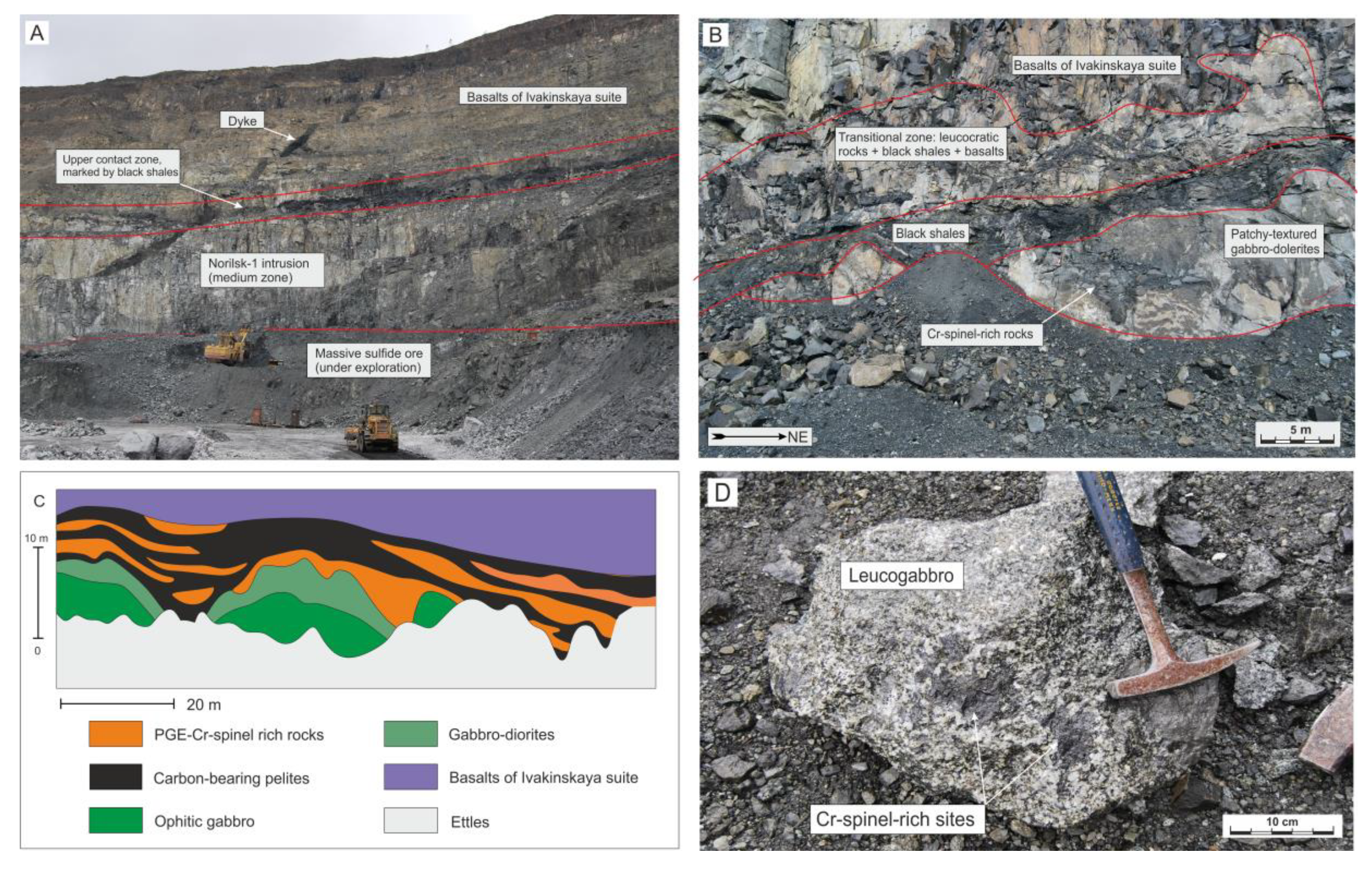

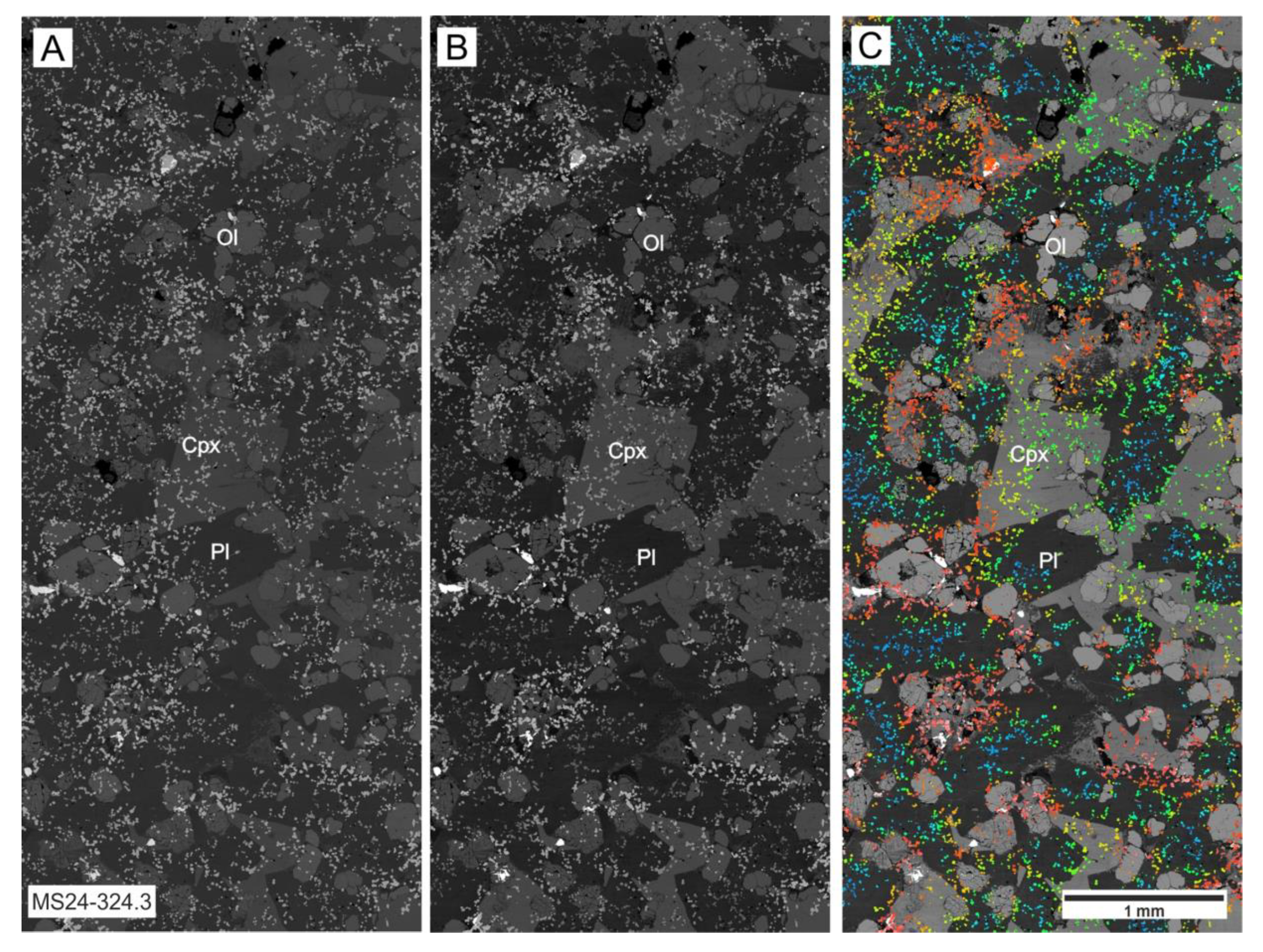

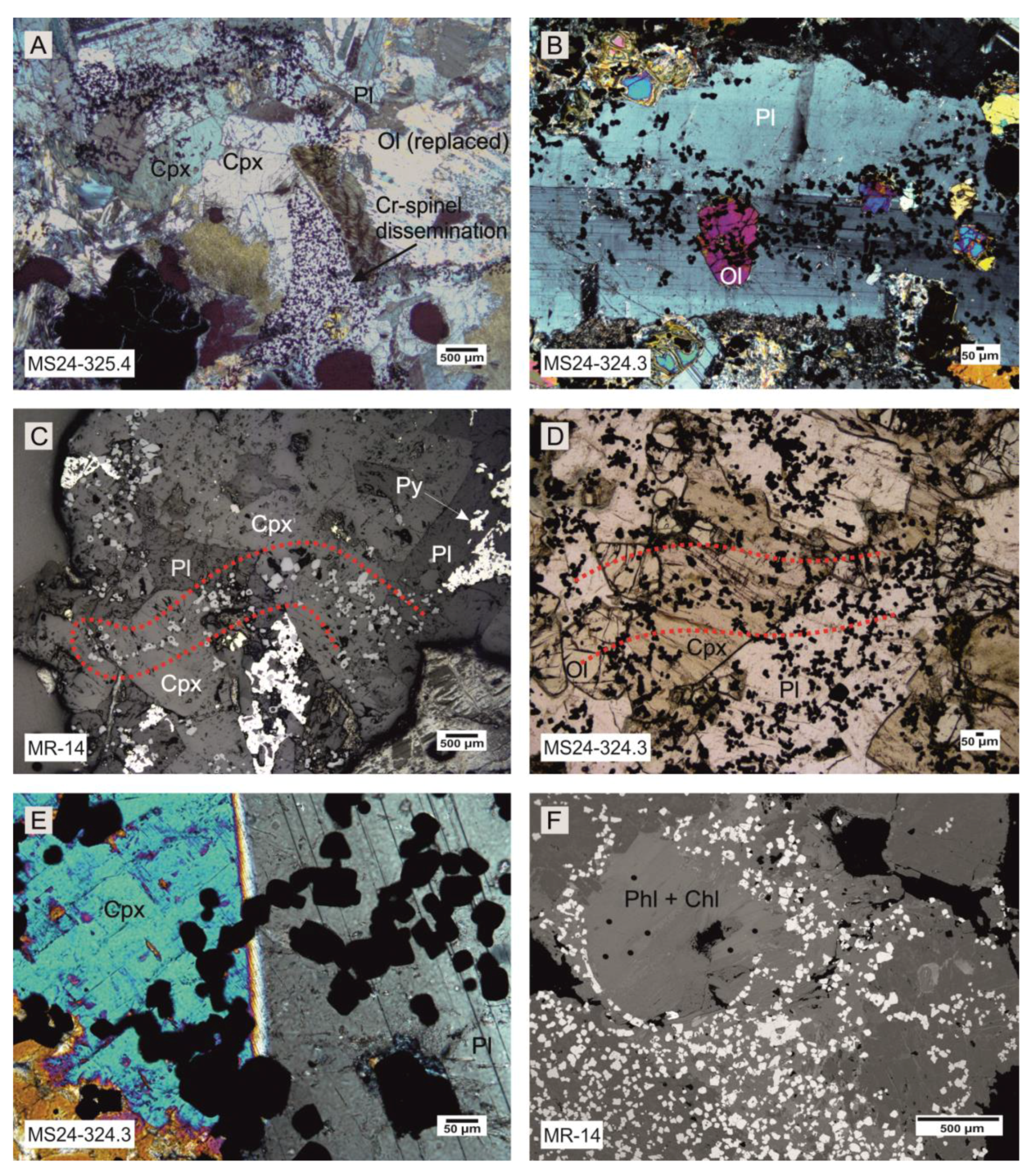

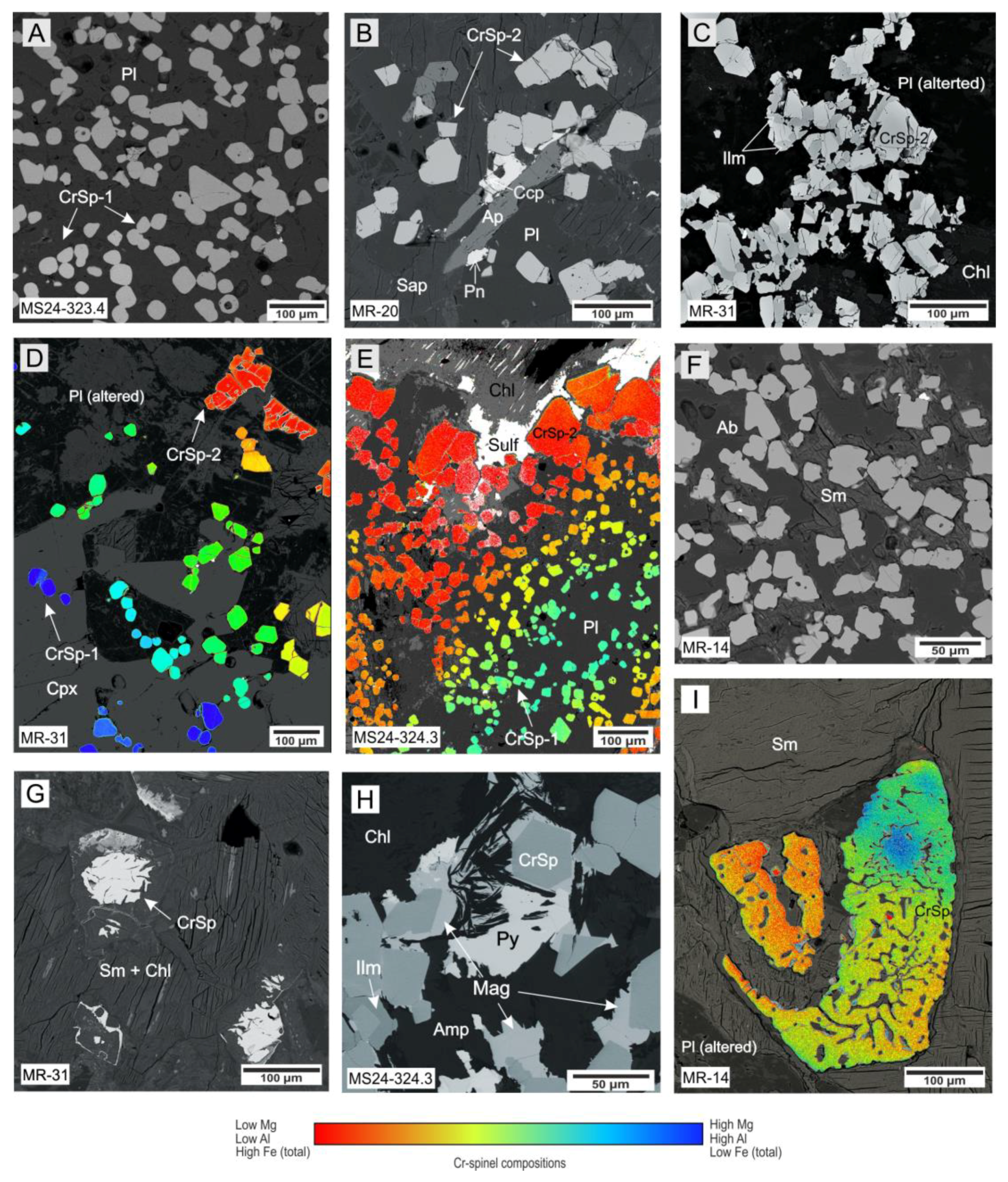
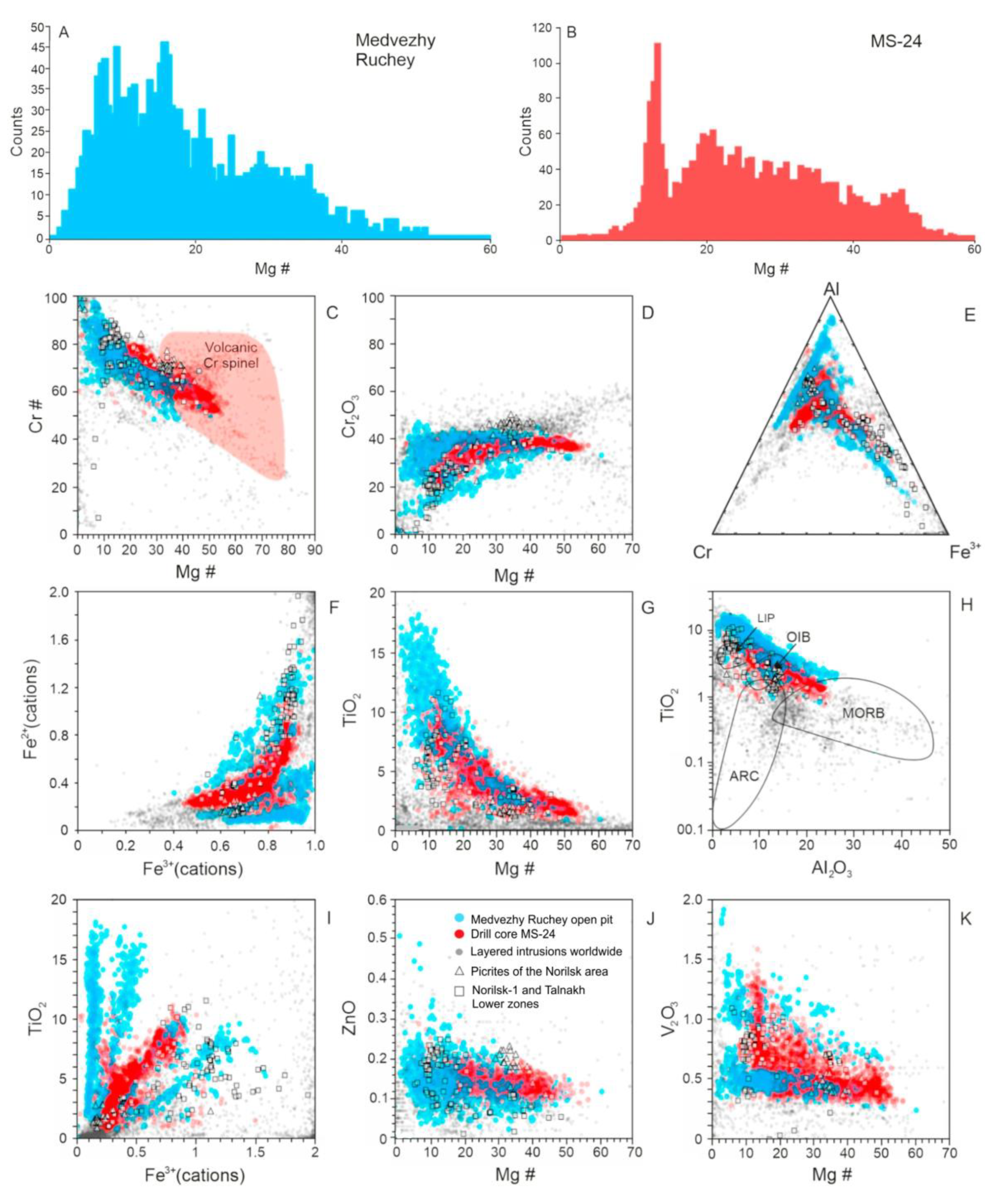
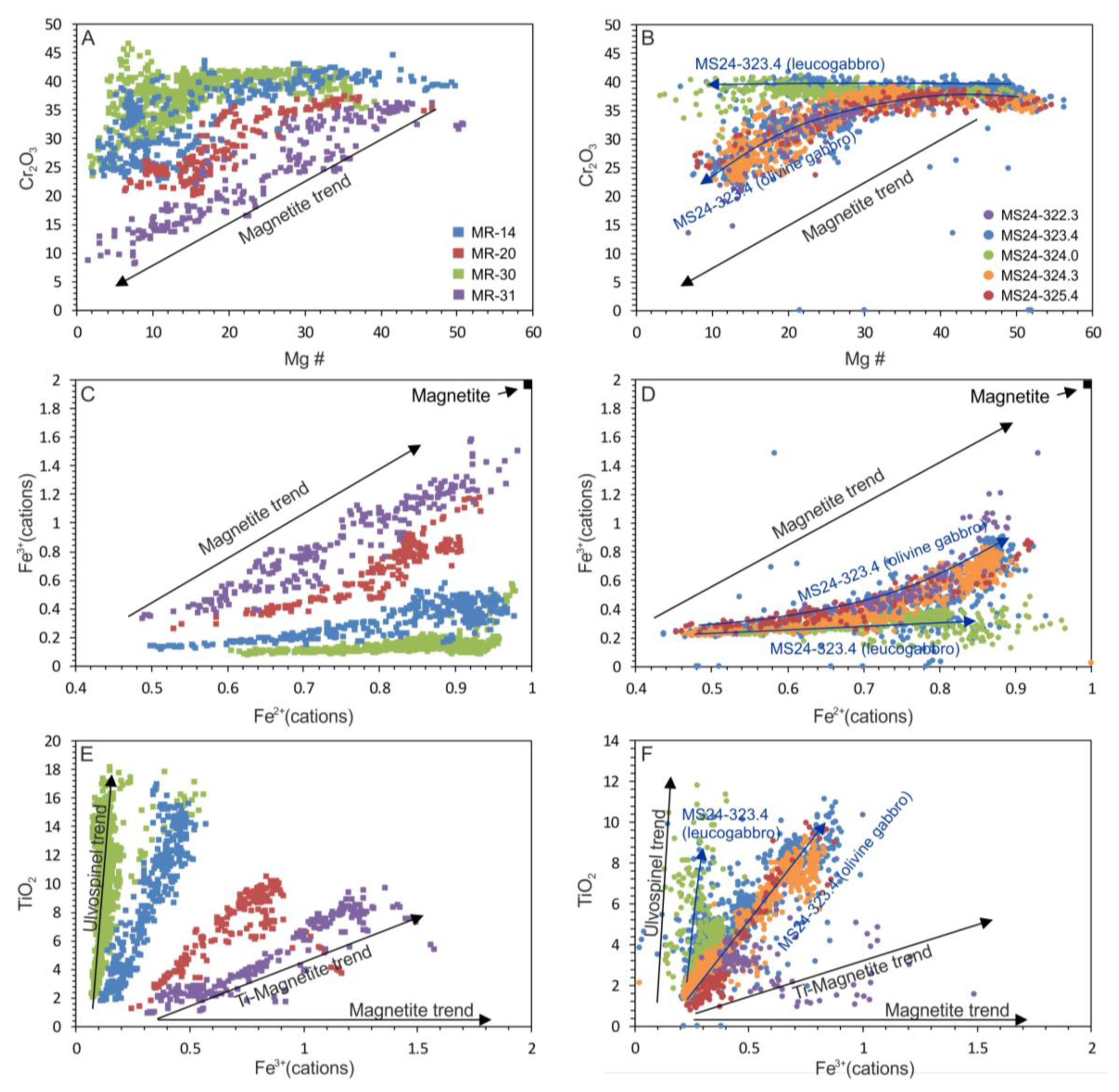
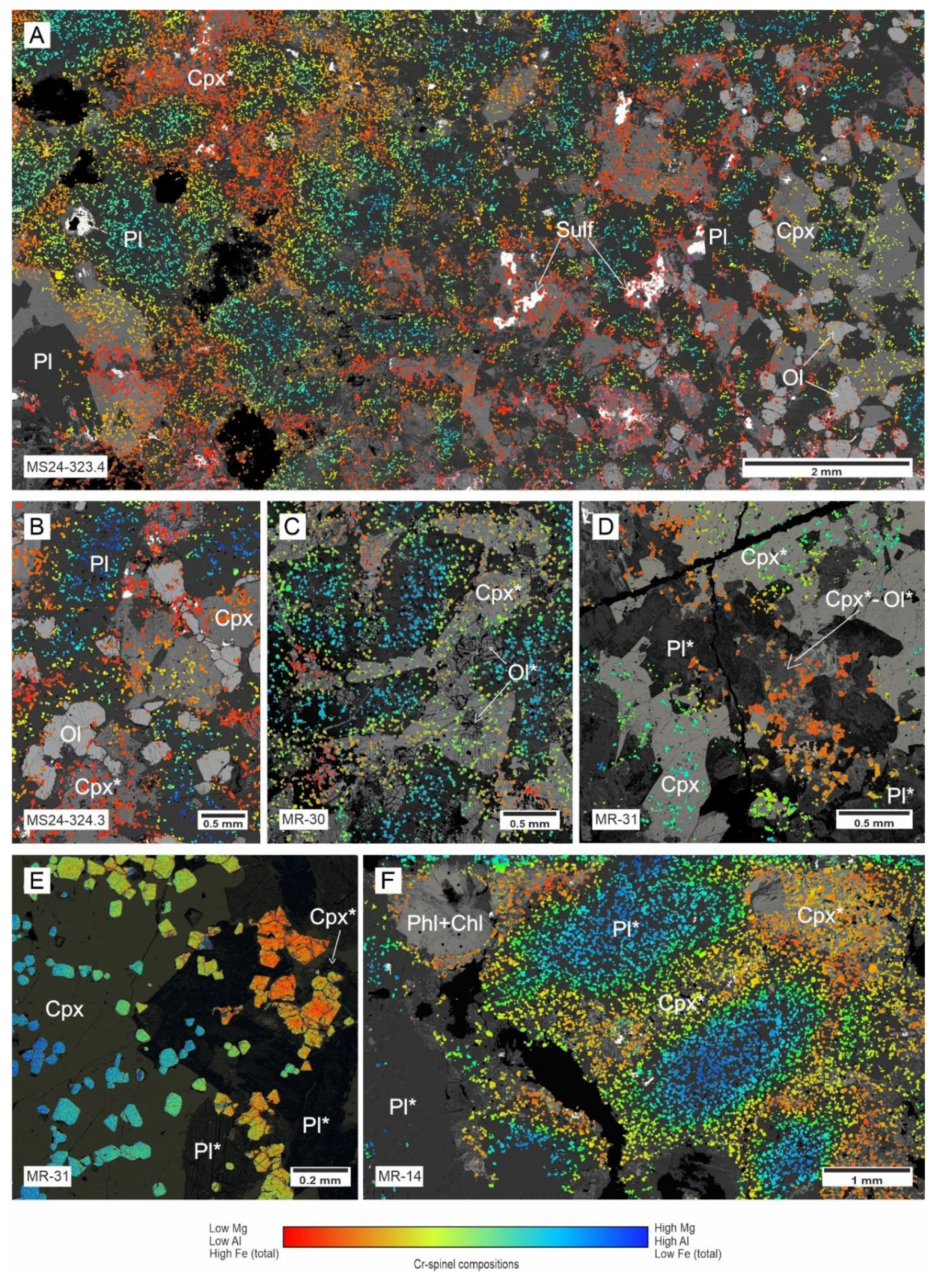
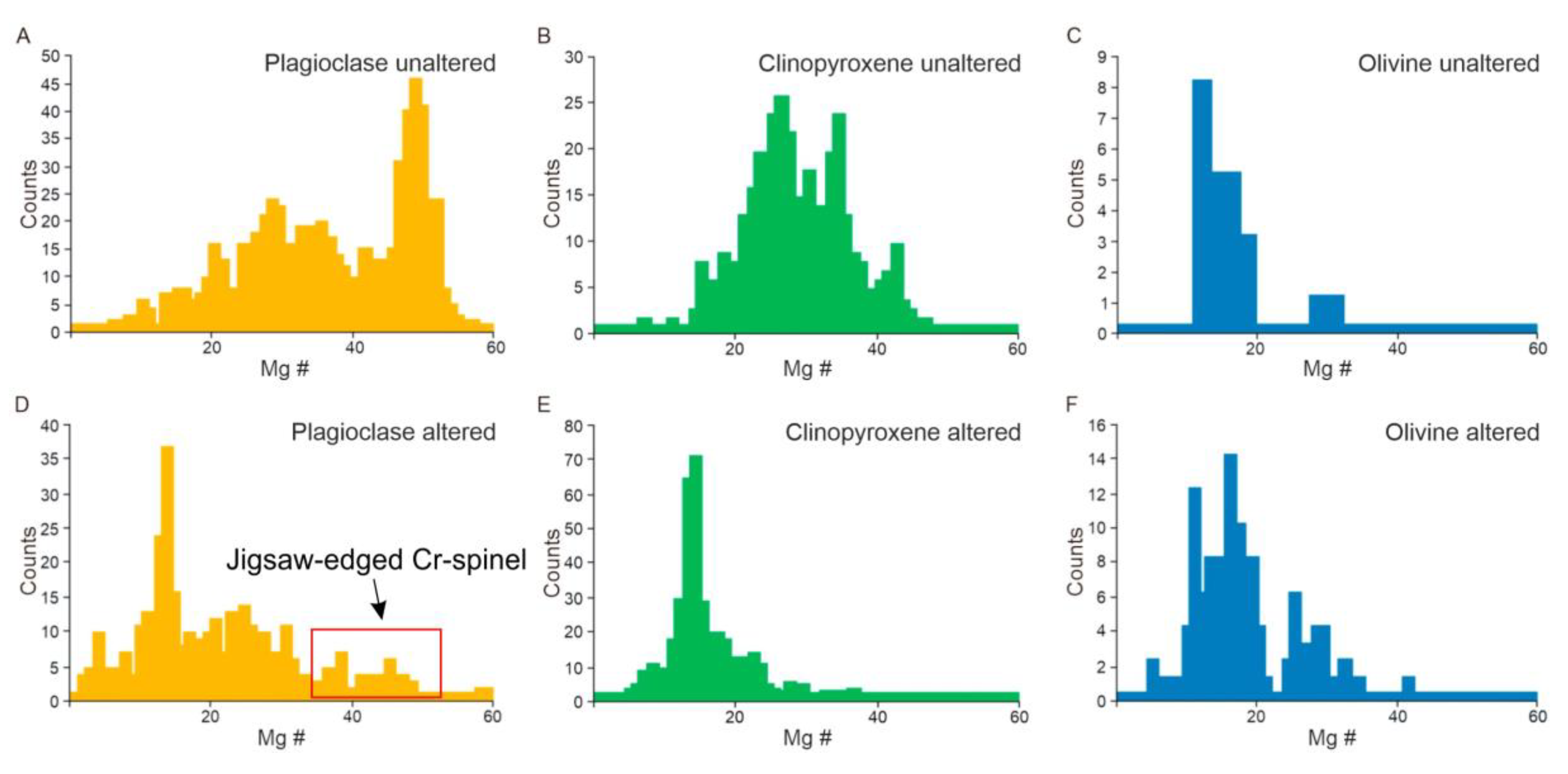
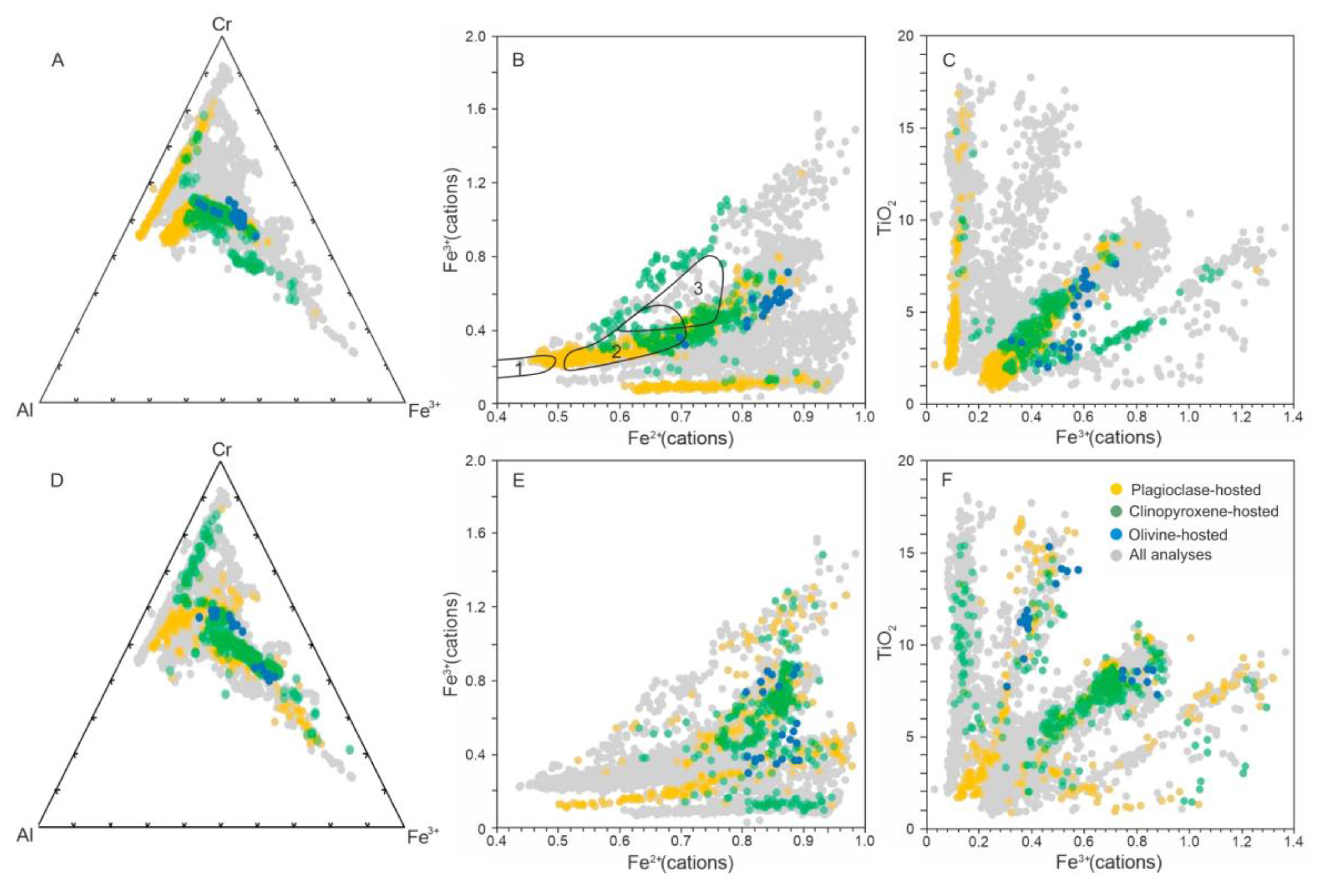
| Sample | Rock Type | Silicate Matrix 1 | CrSp 2 | Texture |
|---|---|---|---|---|
| MR-14 | Leucogabbro | Pl *+Cpx+Ol * | +++ | Tabular Pl * grains with interstitial Cpx *. Sites with >95 vol. % of Pl * are present. Cr-spinel forms cloud-like abundant disseminations, which have distinct borders. Sulfide (pyrrhotite+chalcopyrite+pentlandite) mineralization is relatively scarce, but associated PGMs are abundant. |
| MR-20 | Ophitic gabbro | Pl+Cpx *+Ol * | + | Euhedral elongated Pl with interstitial or poikilithic Cpx *. Occasional sites, moderately enriched of Cr-spinel |
| MR-30 (1) 3 | Troctolite/leucogabbro | Pl+Ol *+Cpx *+Opx * | ++ | Euhedral tabular Pl with interstitial mafic minerals. Cr-spinel dissemination is relatively abundant, disperse and homogeneous. |
| MR-30 (2) | Ophitic gabbro | Pl+Cpx *+Ol * | + | Euhedral elongated Pl with interstitial or poikilithic Cpx *. Moderately enriched in Cr-spinel |
| MR-30 (3) | Ophitic gabbro (olivine-free) | Pl *+Cpx * | - | Elongated Pl with interstitial Cpx. No Cr-spinel. |
| MR-31 | Ophitic gabbro | Pl+Cpx+Ol * | + | Euhedral elongated Pl with interstitial or poikilithic Cpx *. Occasional sites, moderately enriched of Cr-spinel |
| MS24-321.9 | Ophitic gabbro | Pl *+Cpx *+Ol * | + | Euhedral elongated Pl with interstitial or poikilithic Cpx * and subhedral Ol *. Thin “reef-like” band of Cr-spinel with scarce sulfides (pyrrhotite + chalcopyrite + pentlandite). |
| MS24-322.3 | Ophitic gabbro | Pl+Cpx+Ol * | Scarce | Euhedral elongated Pl with interstitial or poikilithic Cpx * and subhedral Ol *. Cr-spinel is only occasional. |
| MS24-323.4 (1) | Leucogabbro | Pl+Cpx *+Ol * | +++ | Tabular Pl with interstitial Cpx * and scarce Ol *. Cr-spinel dissemination is dense and homogeneous with occasional Cr-spinel-free sites. Sulfide (pyrrhotite+chalcopyrite+pentlandite) clusters up to 5 mm. |
| MS24-323.4 (2) | Olivine-rich ophitic gabbro | Pl+Cpx+Ol | ++ | Euhedral Pl and Ol with interstitial and poikilithic Cpx. Cr-spinel dissemination is moderately dense and homogeneous. |
| MS24-324.0 | Leucogabbro | Pl *+Cpx *+Ol * | +++ | Tabular Pl * with interstitial Cpx *. Cr-spinel dissemination is dense and homogeneous. Sulfide clusters (pyrrhotite+chalcopyrite+pentlandite). up to 5 mm. |
| MS24-324.3 | Olivine-rich ophitic gabbro | Pl+Cpx+Ol | ++ | Euhedral Pl and Ol with interstitial and poikilithic Cpx. Cr-spinel dissemination is moderately dense and homogeneous. |
| MS24-325.4 | Leucogabbro | Pl+Cpx *+Ol * | ++ | Tabular Pl * with interstitial Cpx *. Cr-spinel dissemination is dense, but uneven. Sulfide clusters (pyrrhotite + chalcopyrite + pentlandite) are present. |
© 2020 by the authors. Licensee MDPI, Basel, Switzerland. This article is an open access article distributed under the terms and conditions of the Creative Commons Attribution (CC BY) license (http://creativecommons.org/licenses/by/4.0/).
Share and Cite
Chayka, I.F.; Zhitova, L.M.; Antsiferova, T.N.; Abersteiner, A.; Shevko, A.Y.; Izokh, A.E.; Tolstykh, N.D.; Gora, M.P.; Chubarov, V.M.; Kamenetsky, V.S. In-Situ Crystallization and Continuous Modification of Chromian Spinel in the “Sulfide-Poor Platinum-Group Metal Ores” of the Norilsk-1 Intrusion (Northern Siberia, Russia). Minerals 2020, 10, 498. https://doi.org/10.3390/min10060498
Chayka IF, Zhitova LM, Antsiferova TN, Abersteiner A, Shevko AY, Izokh AE, Tolstykh ND, Gora MP, Chubarov VM, Kamenetsky VS. In-Situ Crystallization and Continuous Modification of Chromian Spinel in the “Sulfide-Poor Platinum-Group Metal Ores” of the Norilsk-1 Intrusion (Northern Siberia, Russia). Minerals. 2020; 10(6):498. https://doi.org/10.3390/min10060498
Chicago/Turabian StyleChayka, Ivan F., Liudmila M. Zhitova, Tatiana N. Antsiferova, Adam Abersteiner, Artem Ya. Shevko, Andrey E. Izokh, Nadezhda D. Tolstykh, Marina P. Gora, Valery M. Chubarov, and Vadim S. Kamenetsky. 2020. "In-Situ Crystallization and Continuous Modification of Chromian Spinel in the “Sulfide-Poor Platinum-Group Metal Ores” of the Norilsk-1 Intrusion (Northern Siberia, Russia)" Minerals 10, no. 6: 498. https://doi.org/10.3390/min10060498
APA StyleChayka, I. F., Zhitova, L. M., Antsiferova, T. N., Abersteiner, A., Shevko, A. Y., Izokh, A. E., Tolstykh, N. D., Gora, M. P., Chubarov, V. M., & Kamenetsky, V. S. (2020). In-Situ Crystallization and Continuous Modification of Chromian Spinel in the “Sulfide-Poor Platinum-Group Metal Ores” of the Norilsk-1 Intrusion (Northern Siberia, Russia). Minerals, 10(6), 498. https://doi.org/10.3390/min10060498






